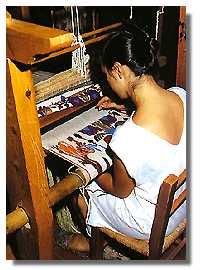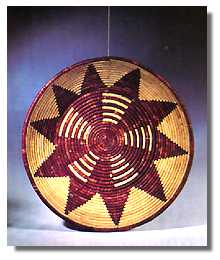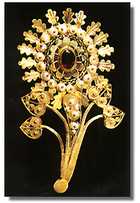
Although hand-loomed articles are produced all
over the island, two villages in the Marmilla region, Mogoro and Morgongiori, are
the most important centers of production. The wealth of traditional colors and designs
is vast and it is not always easy to determine a place of origin, given the similarity
of motifs used in different areas. A rule of thumb is that horizontally patterned,
monochromatic textiles generally come from the mountain regions, and in other areas
such as Sarrabus and Marmilla, strong colors and tightly textured weaving predominate.
The repertory of ornamental motifs represents a rich symbolic heritage, with elements
borrowed from other cultures and traditions. The asphodel, a common wildflower, represents
pain and regret. Heraldic devices like towers, castles, lions, and griffons date from the medieval period.
The eagle is sometimes considered a metaphor for Christ's resurrection.

Religious symbolism is displayed in the use of the dove, representing
goodness; the grape, representing communion between God and his people; and the peacock, symbolizing eternal
life to the Byzantines. Other designs include branches and buds, lambs, deer, fountains, grain, and horses and riders.
Magical symbols such as the sun, moon, stars, and hourglasses appear as well as purely local designs like
ponies similar to the ones found on the Giara of Gesturi plateau.
An excellent shop where authenticity is guaranteed is ISOLA, run by the regional agency
responsible for promoting and encouraging local handicrafts. The store is located
at Via Bacaredda 176. For carpets and wall hangings in particular, the annual fair
at Mogoro, held during the last week of July and the first week of August, is very interesting.
|







